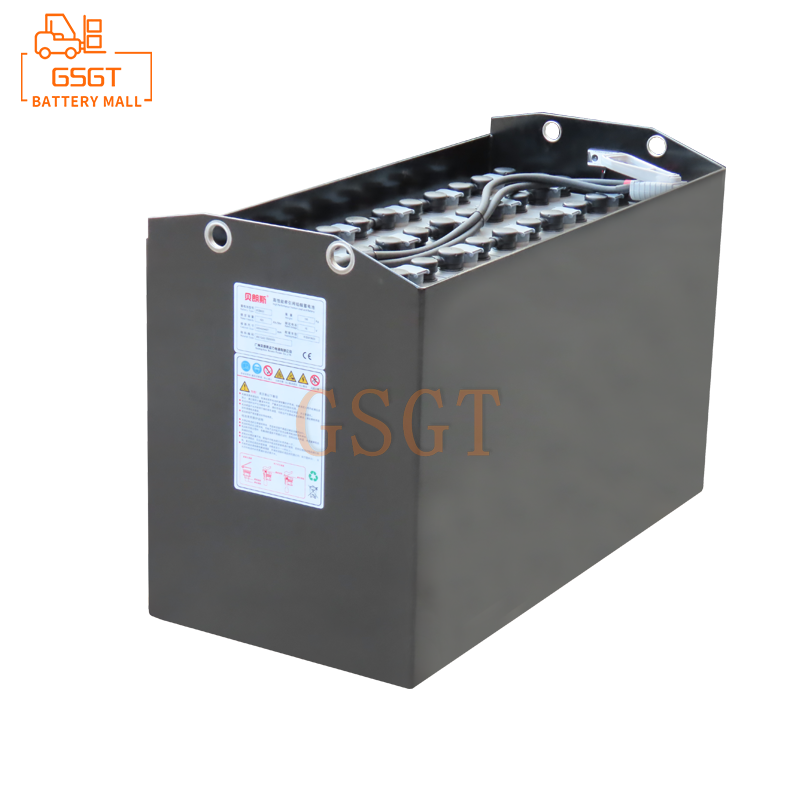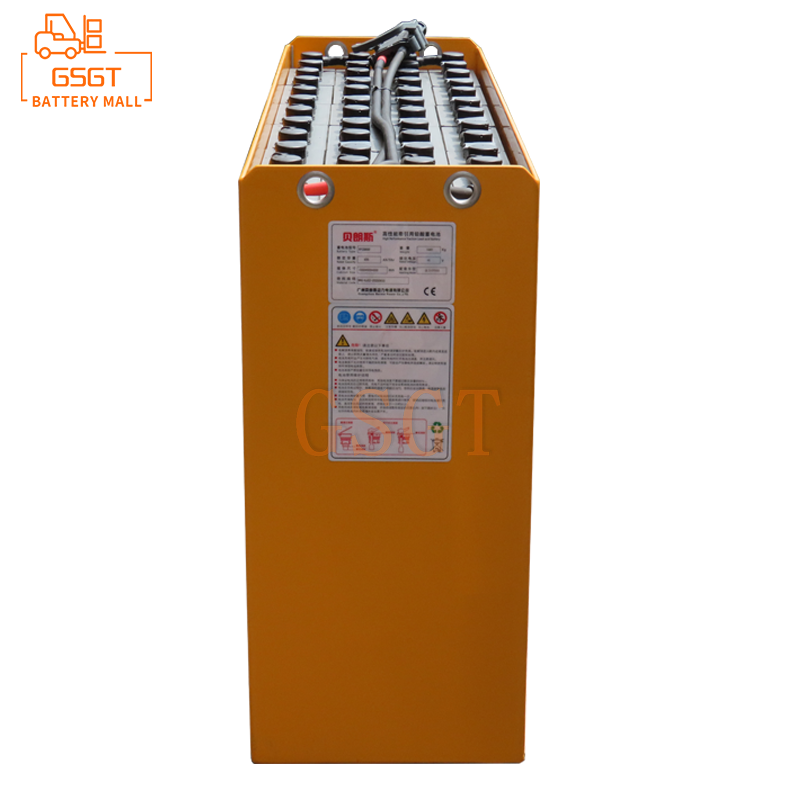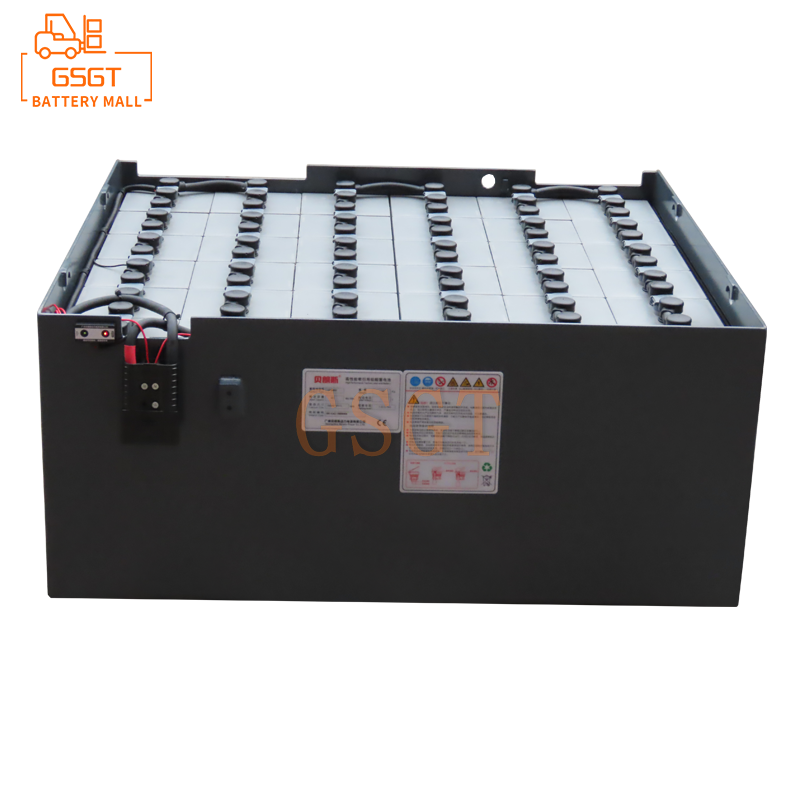Time:2025-04-19 11:37:01
Browse:528
Abstract
This article deeply explores the safety design and safeguard measures of lead-acid batteries for forklifts. The safety hazards existing in the application of lead-acid batteries in forklifts were analyzed in detail. The key points of safety design were expounded from aspects such as battery structure, material selection, and electrical system, and a series of safeguard measures were proposed, including daily maintenance, personnel training, and environmental management, aiming to improve the safety of lead-acid batteries in forklifts and reduce the occurrence of safety accidents. Provide a strong guarantee for the safe and efficient operation of forklifts.
1. Introduction
In the modern logistics and warehousing industry, forklifts, as important handling equipment, are widely used in various fields. Lead-acid batteries have become the main power source for forklifts due to their advantages such as mature technology, low cost and large capacity. However, lead-acid batteries have many safety hazards during use, such as battery leakage, explosion, fire, and electric shock. These safety issues not only affect the normal operation of forklifts but may also endanger the lives of operators and the property safety of enterprises. Therefore, it is of great practical significance to conduct research on the safety design and safeguard measures of lead-acid batteries for forklifts.
2. Safety Hazards of Lead-acid Batteries in Forklifts
(1) Battery leakage
Lead-acid batteries contain sulfuric acid electrolyte inside. If the battery casing is damaged or the seal is poor, the sulfuric acid electrolyte may leak out. The leaked sulfuric acid electrolyte is highly corrosive and can cause corrosion damage to the metal parts of the forklift, the ground, etc. At the same time, it may also cause burns to the skin and eyes of the operators. In addition, electrolyte leakage will lead to a reduction in the electrolyte inside the battery, affecting its performance and service life.
(2) Explosion and Fire
During the charging and discharging process of lead-acid batteries, gases such as hydrogen and oxygen are produced. When too much gas accumulates inside a battery and it is exposed to open flames, electric sparks or other fire sources, an explosion may occur. In addition, if there is a short circuit inside the battery, a large amount of heat will be generated, causing the battery temperature to rise sharply and possibly leading to a fire. Battery explosions and fires not only cause damage to the batteries themselves, but also may cause serious harm to the surrounding equipment and personnel.
(3) Risk of electric shock
The voltage of lead-acid batteries in forklifts is usually relatively high, generally ranging from 24V to 80V. If the electrical connection components of the battery are loose or the insulation layer is damaged, the operator may come into contact with the live parts during operation, thereby causing an electric shock accident. In addition, when maintaining and inspecting batteries, if the operation is improper, it is also easy to cause the risk of electric shock.
3. Safety Design of Lead-Acid Batteries for Forklifts
(1) Battery Structure Design
1. ** Shell Material selection **
The battery casing is made of high-strength and corrosion-resistant materials, such as polypropylene (PP), polyvinyl chloride (PVC), etc. These materials have excellent acid resistance and impact resistance, which can effectively prevent the battery casing from being damaged due to collision or compression, thereby avoiding electrolyte leakage. Meanwhile, the shell material should have a certain degree of flame retardancy. In case of fire or other situations, it can delay the spread of the fire and reduce the risk of fire.
2. ** Sealing Structure Design **
Advanced sealing technology is adopted to ensure the battery's sealing performance. For instance, by adopting a hot-pressing sealing process, the battery casing is closely combined with components such as the plate group and separator to prevent electrolyte leakage and gas escape. In addition, a sealing rubber ring is set between the battery cover and the casing to further enhance the sealing effect. At the same time, the exhaust system of the battery should be reasonably designed to ensure that the gas generated inside the battery can be safely discharged and prevent gas accumulation from causing an explosion.
(2) Material Selection
1. "Plate material
The plates are the core components of lead-acid batteries, and the performance of their materials directly affects the safety and service life of the batteries. High-purity lead alloys are selected as the plate materials, such as lead-calcium alloys and lead-antimony alloys. Lead-calcium alloy has the advantages of low self-discharge rate and less gas evolution, which can effectively reduce the generation of gas inside the battery and lower the risk of explosion. At the same time, improve the manufacturing process of the plates to ensure uniform thickness and smooth surface of the plates, and avoid internal short circuits in the battery caused by plate quality issues.
2. ** Partition material **
The function of the separator is to separate the positive and negative plates and prevent short circuits. Select partition materials with good insulation performance and chemical stability, such as microporous rubber partitions and glass fiber partitions. These separator materials have a high porosity, which can ensure the smooth passage of the electrolyte while effectively preventing the active substances on the plates from falling off and avoiding internal short circuits in the battery. In addition, the separator material should have a certain mechanical strength, capable of withstanding the internal pressure and vibration of the battery to ensure its normal operation.
(3) Electrical System Design
1. Overcharge and overdischarge protection
During the charging and discharging process of lead-acid batteries in forklifts, overcharge and overdischarge protection devices are set up. When the battery charging reaches the upper limit of the set voltage, the overcharge protection device will automatically cut off the charging circuit to prevent the battery from overheating, bulging or even exploding due to overcharging. When the battery discharge reaches the lower limit of the set voltage, the over-discharge protection device will automatically cut off the discharge circuit to prevent the battery from being damaged due to over-discharge and extend the battery's service life.
2. Short-circuit protection
In the electrical connection lines of the battery, short-circuit protection devices such as fuses and circuit breakers should be installed. When a short circuit occurs in the circuit, the short-circuit protection device can quickly cut off the circuit to prevent fires and equipment damage caused by excessive short-circuit current. Meanwhile, the electrical connection components are optimized in design, and anti-loosening and anti-oxidation connection methods are adopted to ensure the reliability of electrical connections and reduce the risk of short circuits caused by poor connections.
4. Safeguard Measures for Lead-Acid Batteries in Forklifts
(1) Daily Maintenance
1. Regular inspection
Establish a strict battery inspection system and conduct regular appearance checks, voltage tests, and electrolyte density tests on forklift lead-acid batteries. Check whether the battery casing is damaged, deformed, or leaking, etc. Check whether the battery connection terminals are loose or oxidized, and measure whether the battery voltage and electrolyte density are within the normal range. Through regular inspections, problems with the battery can be detected in a timely manner, and corresponding measures can be taken to deal with them to ensure the safe operation of the battery.
2. Electrolyte replenishment
Replenish the electrolyte regularly according to the usage of the battery. When replenishing the electrolyte, distilled water or dedicated lead-acid battery replenishment fluid should be used. Avoid using water containing impurities such as tap water to prevent impurities from entering the battery and affecting its performance. At the same time, the amount of electrolyte replenished should be appropriate to avoid either too much or too little. Excessive electrolyte is prone to overflow during battery charging and discharging, while too little electrolyte will cause the plates to be exposed, accelerating their sulfation and damage.
(2) Personnel Training
1. Operator training
Provide specialized training on the use and safety knowledge of lead-acid batteries for forklift operators, enabling them to understand the working principle, performance characteristics, and safety operation procedures of lead-acid batteries. The training content includes how to start and stop forklifts correctly, how to observe the battery status, and how to avoid overcharging and overdischarging the battery, etc. Through training, enhance the safety awareness and operational skills of operators and reduce safety accidents caused by improper human operation.
2. Maintenance Personnel training
Provide professional technical training for battery maintenance personnel to enable them to master the skills of battery maintenance and repair. The training content includes battery disassembly, installation, fault diagnosis, repair, etc. At the same time, strengthen the safety awareness education of maintenance personnel, making them strictly abide by the safety operation procedures during maintenance and repair, and wear necessary protective equipment such as gloves and goggles to prevent accidents such as electric shock and acid burns.
(3) Environmental Management
1. "Charging environment
A dedicated charging area should be set up for the lead-acid batteries of forklifts. The charging area should be well-ventilated and kept away from flammable, explosive items and fire sources. The ground of the charging area should be paved with acid-resistant and anti-slip materials. Anti-acid leakage cofferdams and drainage systems should be set up to prevent electrolyte leakage from polluting the environment. Meanwhile, obvious safety warning signs should be set up in the charging area to remind people to pay attention to safety.
2. Storage environment
When not in use, batteries should be stored in a dry, well-ventilated and cool environment, avoiding direct sunlight and high-temperature and humid conditions. The temperature of the storage environment should be controlled within an appropriate range, generally between 5℃ and 35℃. Both excessively high and low temperatures will affect the performance and service life of the battery. At the same time, prevent the battery from being subjected to external forces such as squeezing and collision during storage to avoid damage to the battery casing.
5. Conclusion
The safety design and safeguard measures of lead-acid batteries in forklifts are important links to ensure the safe operation of forklifts. Through reasonable safety design, starting from aspects such as battery structure, material selection, and electrical system, the intrinsic safety performance of the battery can be improved; At the same time, taking effective safeguard measures, including daily maintenance, personnel training, environmental management, etc., can promptly identify and eliminate potential safety hazards and reduce the probability of safety accidents. Only by organically integrating safety design with safeguard measures can comprehensive guarantees be provided for the safe and reliable operation of forklift lead-acid batteries, promoting the safe and efficient development of the logistics and warehousing industry. In the future development, with the continuous advancement of technology, it is also necessary to continuously explore more advanced safety design concepts and safeguard measures to further enhance the safety and reliability of forklift lead-acid batteries.

$2450

$3810

$4045

$2140

MESSAGE
Professional And Efficient
Security
Affordable Price
Professional Services